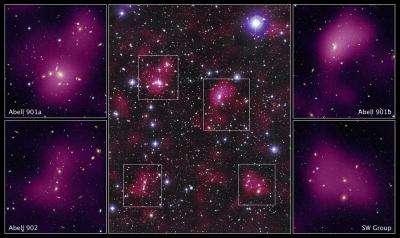Astronomers produce first detailed map of dark matter in a supercluster

For the first time astronomers are able to see indirect evidence of dark matter and how this invisible force impacts on the crowded and violent lives of galaxies. University of British Columbia researcher Catherine Heymans has produced the highest resolution map of dark matter ever captured before.
Scientists believe that dark matter is the invisible web that houses galaxies. And as the universe evolves, the gravitational pull of this unseen matter causes galaxies to collide and swirl into superclusters.
Heymans and the University of Nottingham’s Meghan Gray led an international team to test this theory that dark matter determines the location of galaxies.
“For the first time we are clearly detecting irregular clumps of dark matter in a supercluster,” says Heymans, a postdoctoral fellow in the Dept. of Astronomy and Physics.
“Previous studies were only able to detect fuzzy, circular clumps, but we’re able to resolve detailed shapes that match the distribution of galaxies.”
Using NASA’s Hubble Space Telescope, Heymans and her team viewed an area of sky approximately the size of the full moon. They mapped the invisible dark matter scaffolding of the massive supercluster Abell 901/902 and the detailed structure of the individual galaxies embedded in it.
Abell 901/902 resides 2.6 billion light-years from Earth and measures more than 16 million light-years across.
“It is to the universe what New York is to America - a huge, fascinating but frightening place,” says Heymans.
“Dark matter leaves a signature in distant galaxies” explains study co-author Ludovic Van Waerbeke, an assistant professor in the Department of Physics and Astronomy. “For example, a circular galaxy will become more distorted to resemble the shape of a banana if its light passes near a dense region of dark matter.”
By observing this effect, astronomers can then infer the presence of dark matter. Heymans constructed a dark matter map by measuring the distorted shapes of more than 60,000 faraway galaxies located behind the Abell 901/902 supercluster. To reach Earth, these galaxies’ light traveled through the dark matter that surrounds the Abell 901/902 supercluster of galaxies and was bent by its massive gravitational field.
The Hubble study pinpointed four main areas in the supercluster where dark matter has pooled into dense clumps, totaling 10 trillion times the Sun’s mass. These areas match the known location of hundreds of old galaxies that have experienced a violent history in their passage from the outskirts of the supercluster into these dense regions.
Gray and Heymans will present their findings on Jan. 10 at the 211th meeting of the American Astronomical Society in Austin, Texas. The results are also scheduled to appear in the Monthly Notices of the Royal Astronomical Society.
Source: University of British Columbia




















